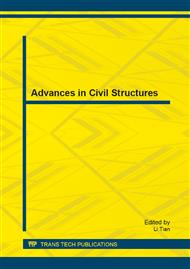p.699
p.704
p.708
p.713
p.717
p.722
p.726
p.730
p.734
An Experimental Study on the Flexural Behavior of Post-Tensioned Concrete Beams with CFRP Tendons
Abstract:
The exploitation of FRP tendon necessitates not only to improve the performances of the FRP tendon and anchoring device but also to examine its structural performances by applying it to various structures like concrete structures. This study applies CFRP tendon on internally and externally post-tensioned concrete specimens so as to observe their flexural performance considering the number of tendons and jacking force as test variables. The tests show that the externally post-tensioned specimens undergo lesser cracks with wider distribution of the cracks than the internally post-tensioned specimens with similar jacking force. In addition, the externally post-tensioned specimens with larger number of saddles experience smaller number of cracks with larger distribution. The specimens without saddle and the internally post-tensioned specimens with the same jacking force exhibit similar behavior until the yielding of the reinforcement to show different behaviors from the time at which the eccentricities of the tendons start to vary after yielding. The externally post-tensioned specimens with saddle provide increased crack load compared to the specimens without saddle, with an increase of approximately 25% of the ultimate load.
Info:
Periodical:
Pages:
717-721
Citation:
Online since:
August 2013
Authors:
Price:
Сopyright:
© 2013 Trans Tech Publications Ltd. All Rights Reserved
Share:
Citation:


